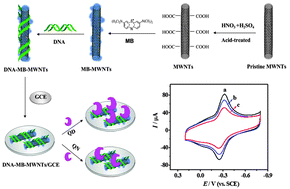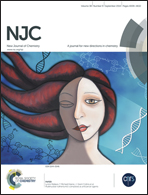DNA-based nanocomposite as electrochemical chiral sensing platform for the enantioselective interaction with quinine and quinidine†
Abstract
A novel chiral sensing platform, employing a biomolecule-based nanocomposite prepared by calf thymus double stranded DNA, methylene blue and multiwall carbon nanotubes (DNA–MB–MWNTs), was utilized for the discrimination of quinine (QN) and quinidine (QD). The DNA-based nanocomposite, which could be used as an electrochemical sensing unit and chiral probe, was characterized by transmission electron microscopy (TEM), ultraviolet-visible spectroscopy (UV-Vis) and cyclic voltammetry (CV). After the proposed sensing platform interacted with QN and QD, a larger electrochemical signal was obtained from QD. The comparative experiments indicated that the proposed strategy not only simplified the fabrication processes but also enhanced the enantioselective interaction in chiral analysis. In addition, experimental factors such as acidity, interaction time and the concentration of enantiomers were investigated in regards to the effect on enantioselective interaction.


 Please wait while we load your content...
Please wait while we load your content...